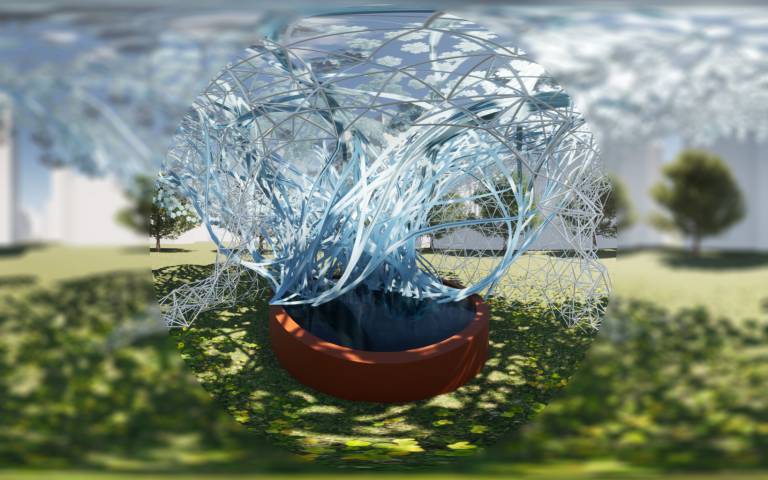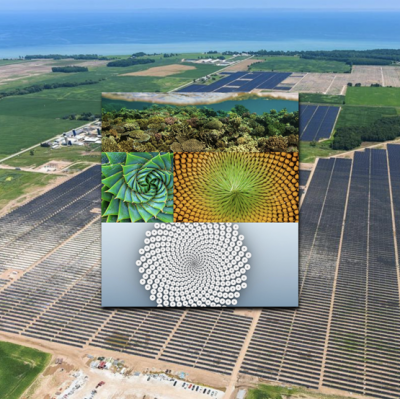Architecture making the most of solar energy at the local level
11 October 2021

At a glance
@R.E.Ar_ : AI Application in Participatory Light-harvesting Design
- @R.E.Ar_ stands for Rational Energy Architecture, focusing on enhancing renewable energy capacities in cities through architectural design.
- Inspired by emerging smart materials like thin-film technologies that are lightweight, flexible, and economical in construction, and potentially able to harvest light in low-lighting conditions, including indoor areas, @R.E.Ar_ is invested in diversifying photovoltaic (PV) designs for diverse solar conditions in the built environment.
- The larger goal is to enhance participatory qualities in light-harvesting and in design.
- Participatory light-harvesting is a form of distributed power generation; energy coming from solar sources can be produced and consumed locally within cities.
- Participatory design is where individuals may contribute to the design process, so we may customise for user needs and unique architectural constraints.
- Artificial Intelligence (AI) can be applied in two ways to assist such goals. 1) forming intelligent design production pipelines that are adaptive to local contexts; 2) forming smart systems that re-distribute power through analysing big data of energy supply and demand.
What is the problem?
If the sun is ever-changing, why should our light-harvesting strategy be always uniform?
Nature has developed a myriad of strategies to harness energy from the sun. For instance, vegetation in rainforest evolves into dense canopies; whereas cacti in deserts developed spines to minimise surface area. Each species develops their unique topological solution to the same problem of light-harvesting, forming a distributed network of energy generation. We, on the other hand, contribute to energy generation in a way that seems counter-logical to evolution: each of our PV designs are uniform and flat. This raises a few subsequent problems. We always need large flat areas, sometimes at the expense of vegetation just to install these panels. PV designs are not adaptive to each other nor to adjacent environments. We often have to transport energy from distant locations causing energy loss. Light-harvesting becomes centralised infrastructure that requires significant investments and individuals have little ways to participate.
What are the key characteristics of the problem?
We are interested in exploring, through our research project, an energy solution that can use and store all of the energy available on the planet. We are seeking to harvest light for distributed power generation, in contrast to the centralised system of light-harvesting, for example, Concentrated Solar Power (CSP) generation.
We do not need to look far in the search for efficient distributed power generation. Territorial and aquatic biology has already covered the entire earth with light-harvesting capacities. The key challenge is to understand the dynamic between organisms and their resulting ecology. For instance, fungi do not harvest light, but they employ an inextricable network of thread-like bacterial colonies - mycelium - that breaks down nutrients and contributes to the organic fraction of the soil, which in turn supports the neighbouring vegetation that carries out photosynthesis. Recent material advancements enable us to further mimic such energy exchanges. For instance, Luminescent Solar Concentrators (LSC) do not harvest light, but they are transparent and may direct light to its neighbouring PV elements, which is especially useful in designing light-harvesting windows.
The amount of data and information that has to be considered suggests that the complexity of the problem cannot be dealt with by human intelligence alone. We need the help of machines that can help us in understanding, simulating, and encoding biological intelligence. How can humans collaborate with machines to produce participatory light-harvesting designs that are sustainable?

What is the solution?
Human-machine Interaction (HMI)
HMI is the exchange between humans and machines, particularly computers, and more recently, in fields of applied Artificial Intelligence (AI). Machines become intelligent by learning from social, biological, and economic data. The challenge is twofold:
- Machines have to be able to interact with various users differently, from general citizens who participate in light-harvesting, to designers who accommodate options according to these needs, producing intelligent design pipelines that are adaptive to individual user needs, local socioeconomic contexts, and architectural constraints.
- Smart systems help in sensing, actuating, and controlling energy exchanges, but not every building has the same solar capacities. AI may help in analysing big data of solar energy potential, generation, and consumption, and help with designing towards power redistribution.
What is AI?
AI is the scientific field that “builds intelligent entities”, and is often associated with the automation of intellectual labour; yet, it does not need to mimic what humans would do in the same situation. It’s core characteristic is the ability to artificially reason over complex cases. We use Machine Learning (ML) - a type of AI -for design automation, in order to create a scalable design system that generates several possible resolutions from complex urban scenarios.
Data produced from biological design studies create the training material that assists the machine to learn hidden patterns and predicts results in a relatively instantaneous manner. Given an urban context as input, the trained ML model is able to define a strategy that accumulates the most solar radiation on a target structure. This not only helps to optimise designs, but may also facilitate a participatory approach that adapts to different user inputs efficiently.
What is stopping the solution being implemented and how can these barriers be removed?
Currently, many softwares and algorithms are not free to use and are incompatible with one another, which hinder collaboration and participatory practices in design. New financial models are needed, through which software enterprises can sustain their business while the average individual can still afford to participate.
@R.E.Ar_ pushes at the limits to knowledge domains in material engineering, built environment planning, generative design, and biological research. Progress requires collaboration between disciplines (from natural and social sciences) and across scales (from nano to macro). We would also need common data environments that map the Earth’s solar data in a holistic and comprehensive way, requiring interdisciplinary, international, and intercultural collaboration.
Expansion of Research and Development (R&D) is required to make diverse solar design realisable and mass customisation affordable to people on average incomes. Because participatory light-harvesting could radically change the current system of power generation, measures would be needed to help traditional energy industries to transform. This will require public policy to regulate, incentivise, and support private businesses and individuals to participate in light-harvesting, and to stimulate investment in building up local socio economic and infrastructural capacities.
Conclusion
Architecture needs to be understood as an integrative design field that bridges actors across disciplinary and regional borders. In that sense, the discipline must actively lead in designing novel approaches, creating dialogues across urban contexts, and diversifying solutions and perspectives for our everyday problems. The use of AI is not only a fashionable phenomenon; it is one of the ways in which a common language may be cultivated between design, social, and natural sciences.
As these challenges go beyond the intelligence of humans alone, we need to invest in ways of working that allow us to integrate human, machine, and socio-biological intelligence. The resultant data and information have to be understandable and compatible along the whole chain of design production. In order to provide the next generation of architects and individuals with the possibility to participate in its processes of production, built environment knowledge has to be democratised. We must work with the hope that buildings in the future can feed our cities with energy instead of just consuming it.
Key references for further information
- Rationalise energy using irrational numbers, applying it in Architecture & research. Rational Energy ARchitects (@R.E.Ar_) https://www.instagram.com/R.E.Ar_
- ‘AI in+form: Bio-inspired Solar Design’ https://youtube.com/playlist?list=PLxXCSIaLBVbwZC8vjPUbZ04lb7h6bmf8g
- Solar Design Exhibition Gallery in VR https://hubs.mozilla.com/MAV6jk6/ai-in-form-by-at-r-e-ar
 Close
Close


